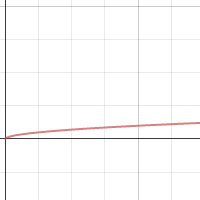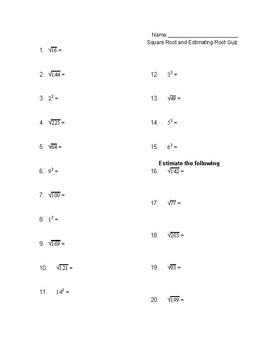Topic square root how to solve: Discover the fundamental methods for solving square roots efficiently. This article breaks down the essential techniques and provides step-by-step guidance to help you understand and solve square root problems with ease. Whether you're a student or just looking to refresh your math skills, this guide will equip you with the knowledge to tackle any square root equation confidently.
Table of Content
- How to Solve Square Roots
- Introduction to Square Roots
- Definition of Square Root
- Properties of Square Roots
- Basic Techniques for Finding Square Roots
- Solving Square Root Equations
- Examples of Solving Square Root Equations
- Applications of Square Roots
- Advanced Topics
- Common Mistakes and How to Avoid Them
- Practice Problems
- Conclusion
- YOUTUBE: Hướng dẫn cách đơn giản hóa căn bậc hai để giúp bạn dễ dàng giải quyết các bài toán liên quan.
How to Solve Square Roots
Square roots are fundamental in mathematics, representing a value that, when multiplied by itself, gives the original number. Solving square roots can be approached through various methods depending on the context.
Basic Definition
The square root of a number \( x \) is a number \( y \) such that \( y^2 = x \). It is denoted as \( \sqrt{x} \). For example, \( \sqrt{16} = 4 \) because \( 4^2 = 16 \).
Methods to Solve Square Roots
- Prime Factorization
Break down the number into its prime factors, then pair the prime factors to find the square root.
- Example: \( \sqrt{36} \)
- Prime factors of 36: \( 36 = 2 \times 2 \times 3 \times 3 \)
- Pair the prime factors: \( (2 \times 3) \times (2 \times 3) \)
- The square root: \( \sqrt{36} = 2 \times 3 = 6 \)
- Example: \( \sqrt{36} \)
- Using a Calculator
Most calculators have a square root function (√). Simply input the number and press the square root button.
- Estimation Method
Find two perfect squares between which the number lies and estimate the square root.
- Example: \( \sqrt{50} \)
- Find perfect squares: \( 49 (7^2) \) and \( 64 (8^2) \)
- \( \sqrt{50} \) is between 7 and 8
- Refine the estimate by averaging: \( 7.1 \) or use more precise methods for better accuracy.
- Example: \( \sqrt{50} \)
- Solving Square Root Equations
Isolate the square root term and square both sides of the equation to solve for the variable.
- Example: Solve \( \sqrt{x} + 3 = 7 \)
- Isolate the square root: \( \sqrt{x} = 4 \)
- Square both sides: \( x = 16 \)
- Example: Solve \( \sqrt{x} + 3 = 7 \)
Square Root Properties
| Property | Description |
| Non-negative result | The square root of a non-negative number is always non-negative. |
| Product property | \( \sqrt{a \times b} = \sqrt{a} \times \sqrt{b} \) |
| Quotient property | \( \sqrt{\frac{a}{b}} = \frac{\sqrt{a}}{\sqrt{b}} \) |
Complex Numbers
When dealing with negative numbers, square roots involve complex numbers. The imaginary unit \( i \) is used, where \( i^2 = -1 \). For example, \( \sqrt{-4} = 2i \).
Applications
Square roots are widely used in various fields including geometry (finding the side length of a square from its area), physics (calculating distances and velocities), and statistics (standard deviation calculations).
Understanding how to solve square roots enhances problem-solving skills and mathematical comprehension, providing a foundation for more advanced concepts.

READ MORE:
Introduction to Square Roots
Square roots are a fundamental concept in mathematics, essential for solving equations, understanding geometry, and numerous applications in sciences and engineering.
A square root of a number \( x \) is a value \( y \) such that \( y^2 = x \). In other words, if \( y \) is a square root of \( x \), then \( y \) squared gives \( x \).
For example, the square root of 9 is 3 because \( 3^2 = 9 \).
Understanding square roots is crucial in various mathematical operations, including simplifying radicals, solving quadratic equations, and calculating geometric properties like areas of squares and circles.
This section will cover the definition of square roots, their properties, techniques for finding them, methods to solve equations involving square roots, practical applications, advanced topics, common mistakes to avoid, and practice problems to reinforce understanding.
Definition of Square Root
The square root of a non-negative real number \( x \), denoted as \( \sqrt{x} \), is a non-negative real number \( y \) such that \( y^2 = x \). In simpler terms, if \( y \) is the square root of \( x \), then multiplying \( y \) by itself yields \( x \).
For example, \( \sqrt{9} = 3 \) because \( 3 \times 3 = 9 \).
If \( x \) is negative, the square root \( \sqrt{x} \) is undefined in the set of real numbers, but it is defined in the set of complex numbers as \( i \sqrt{|x|} \), where \( i \) is the imaginary unit and \( |x| \) denotes the absolute value of \( x \).
The principal square root of a positive number \( x \), denoted \( \sqrt{x} \), is the positive square root. There is also a negative square root \( -\sqrt{x} \) which satisfies \( (-\sqrt{x})^2 = x \).
Properties of Square Roots
Understanding the properties of square roots helps in solving equations, simplifying expressions, and manipulating mathematical formulas effectively. Here are some key properties:
- Product Property: \( \sqrt{ab} = \sqrt{a} \cdot \sqrt{b} \) for non-negative real numbers \( a \) and \( b \).
- Quotient Property: \( \frac{\sqrt{a}}{\sqrt{b}} = \sqrt{\frac{a}{b}} \), where \( b \neq 0 \).
- Power Property: \( (\sqrt{a})^n = \sqrt{a^n} \) for even integers \( n \) and \( a \geq 0 \).
- Inverse Property: \( \sqrt{a} \cdot \sqrt{a} = a \), provided \( a \geq 0 \).
- Identity Property: \( \sqrt{1} = 1 \).
- Zero Property: \( \sqrt{0} = 0 \).
These properties are foundational in algebraic manipulations involving square roots and are crucial for solving various types of mathematical problems.
Basic Techniques for Finding Square Roots
There are several methods to find the square root of a number:
- Estimation Method: Approximate the square root by finding the closest perfect squares around it.
- Prime Factorization Method: Decompose the number into prime factors and simplify the square root expression.
- Long Division Method: Perform long division to find the square root step by step.
- Using a Calculator: Use a scientific calculator to compute the square root directly.
- Newton's Method: Iterative numerical method to approximate the square root.
These techniques are useful depending on the context and the precision required in finding square roots.

Solving Square Root Equations
Solving square root equations involves isolating the square root on one side of the equation and then eliminating the square root by squaring both sides of the equation. Here is a step-by-step guide:
-
Isolating the Square Root:
Ensure that the square root term is by itself on one side of the equation. For example, in the equation:
$$\sqrt{2x + 3} = x - 1$$
The square root is already isolated.
-
Squaring Both Sides:
Square both sides of the equation to eliminate the square root. Using the example above, we get:
$$ (\sqrt{2x + 3})^2 = (x - 1)^2 $$
This simplifies to:
$$ 2x + 3 = x^2 - 2x + 1 $$
-
Rearranging and Solving the Resulting Equation:
Rearrange the equation to form a standard quadratic equation:
$$ x^2 - 4x - 2 = 0 $$
Solve this quadratic equation using methods such as factoring, completing the square, or the quadratic formula.
-
Checking for Extraneous Solutions:
When you square both sides of an equation, you may introduce extraneous solutions. Substitute each solution back into the original equation to verify if it is a true solution. For example, if we solve the quadratic equation above and find the solutions \( x_1 \) and \( x_2 \), we must check:
$$ \sqrt{2x_1 + 3} = x_1 - 1 $$
and
$$ \sqrt{2x_2 + 3} = x_2 - 1 $$
If a solution does not satisfy the original equation, it is extraneous and should be discarded.
Let's look at an example:
Example: Solve the equation \( \sqrt{5x - 4} = x - 2 \)
- Isolate the square root:
It's already isolated in this example.
- Square both sides:
$$ (\sqrt{5x - 4})^2 = (x - 2)^2 $$
Simplifies to:
$$ 5x - 4 = x^2 - 4x + 4 $$
- Rearrange and solve the quadratic equation:
$$ x^2 - 9x + 8 = 0 $$
Factoring, we get:
$$ (x - 1)(x - 8) = 0 $$
So, \( x = 1 \) or \( x = 8 \)
- Check for extraneous solutions:
Substitute \( x = 1 \) back into the original equation:
$$ \sqrt{5(1) - 4} = 1 - 2 $$
$$ \sqrt{1} = -1 $$
This is false, so \( x = 1 \) is extraneous.
Substitute \( x = 8 \) back into the original equation:
$$ \sqrt{5(8) - 4} = 8 - 2 $$
$$ \sqrt{36} = 6 $$
This is true, so the solution is \( x = 8 \).
By following these steps, you can systematically solve square root equations and ensure that you identify and discard any extraneous solutions.
Examples of Solving Square Root Equations
Let's explore some examples to understand how to solve square root equations step by step.
Example 1: Solving a Simple Square Root Equation
Solve the equation: \( \sqrt{x} = 5 \)
- Square both sides of the equation to eliminate the square root: \[ (\sqrt{x})^2 = 5^2 \]
- Simplify the equation: \[ x = 25 \]
- Check the solution by substituting \( x \) back into the original equation: \[ \sqrt{25} = 5 \] The solution is correct.
Example 2: Solving an Equation with a Square Root and a Constant
Solve the equation: \( \sqrt{2x + 3} = 7 \)
- Square both sides of the equation: \[ (\sqrt{2x + 3})^2 = 7^2 \]
- Simplify the equation: \[ 2x + 3 = 49 \]
- Isolate \( x \):
- Subtract 3 from both sides: \[ 2x = 46 \]
- Divide both sides by 2: \[ x = 23 \]
- Check the solution by substituting \( x \) back into the original equation: \[ \sqrt{2(23) + 3} = \sqrt{46 + 3} = \sqrt{49} = 7 \] The solution is correct.
Example 3: Solving an Equation with a Square Root on Both Sides
Solve the equation: \( \sqrt{x + 1} = \sqrt{2x - 3} \)
- Square both sides of the equation: \[ (\sqrt{x + 1})^2 = (\sqrt{2x - 3})^2 \]
- Simplify the equation: \[ x + 1 = 2x - 3 \]
- Isolate \( x \):
- Subtract \( x \) from both sides: \[ 1 = x - 3 \]
- Add 3 to both sides: \[ x = 4 \]
- Check the solution by substituting \( x \) back into the original equation: \[ \sqrt{4 + 1} = \sqrt{5} \quad \text{and} \quad \sqrt{2(4) - 3} = \sqrt{8 - 3} = \sqrt{5} \] The solution is correct.
Example 4: Solving a More Complex Square Root Equation
Solve the equation: \( 3\sqrt{2x + 5} - 4 = 11 \)
- Isolate the square root term: \[ 3\sqrt{2x + 5} = 15 \]
- Divide both sides by 3: \[ \sqrt{2x + 5} = 5 \]
- Square both sides of the equation: \[ (\sqrt{2x + 5})^2 = 5^2 \]
- Simplify the equation: \[ 2x + 5 = 25 \]
- Isolate \( x \):
- Subtract 5 from both sides: \[ 2x = 20 \]
- Divide both sides by 2: \[ x = 10 \]
- Check the solution by substituting \( x \) back into the original equation: \[ 3\sqrt{2(10) + 5} - 4 = 3\sqrt{20 + 5} - 4 = 3\sqrt{25} - 4 = 3(5) - 4 = 15 - 4 = 11 \] The solution is correct.
Applications of Square Roots
Square roots have numerous applications across various fields, from everyday problems to complex scientific computations. Here are some notable examples:
1. Geometry and Area Calculation
Square roots are essential in geometry, especially when dealing with areas and perimeters of shapes. For example, the area of a square can be found if the side length is known, using the formula:
\[
\text{Area} = s^2 \quad \Rightarrow \quad s = \sqrt{\text{Area}}
\]
Additionally, the Pythagorean theorem involves square roots to find the length of the hypotenuse in right triangles:
\[
c = \sqrt{a^2 + b^2}
\]
2. Physics and Engineering Formulas
Square roots are used in various physics and engineering calculations. For example:
- Velocity: The velocity of an object under constant acceleration can be calculated using the formula:
- Natural Frequency: In engineering, the natural frequency of a structure (like a bridge) is determined using square roots to predict how the structure responds to loads.
\[
v = \sqrt{2as}
\]
3. Finance
In finance, square roots are used to calculate stock market volatility. The volatility is the square root of the variance of stock returns, which helps investors assess risk:
\[
\text{Volatility} = \sqrt{\text{Variance}}
\]
4. Statistics
Square roots are crucial in statistical analysis, especially in calculating standard deviation, which measures the dispersion of a data set:
\[
\text{Standard Deviation} = \sqrt{\text{Variance}}
\]
5. Cryptography
Cryptographic algorithms often utilize square roots for secure data transmission. For example, digital signatures and key exchange systems use mathematical properties of square roots to ensure data integrity and security.
6. Navigation
In navigation, square roots help compute distances between points on a map. For instance, the distance \(d\) between two points \((x_1, y_1)\) and \((x_2, y_2)\) is given by:
\[
d = \sqrt{(x_2 - x_1)^2 + (y_2 - y_1)^2}
\]
7. Electrical Engineering
Square roots are used in electrical engineering to calculate power, voltage, and current in circuits:
- Power Calculation: The power in a resistor can be calculated as:
\[
P = \sqrt{V^2 / R}
\]
8. Computer Graphics
In computer graphics, square roots are used to calculate distances between points and lengths of vectors, which are essential in rendering and animation.
9. Cooking
Scaling recipes often requires the use of square roots to maintain the correct proportions of ingredients when increasing or decreasing batch sizes.
10. Photography
The f-number of a camera, which affects exposure and depth of field, is related to the aperture size via square roots. Adjusting the f-number changes the light entering the camera by a factor of the square of the f-number.
These are just a few examples of how square roots are applied in different fields, demonstrating their versatility and importance in both theoretical and practical contexts.
Advanced Topics
In this section, we will explore more advanced topics related to square roots, including solving equations with multiple square roots, and the relationship between complex numbers and square roots.
Solving Equations with Multiple Square Roots
When dealing with equations that contain multiple square roots, the key is to isolate and eliminate the square roots systematically. Here are the steps involved:
- Isolate one of the square root terms.
- Square both sides of the equation to eliminate the isolated square root.
- Simplify the resulting equation and repeat the process if there are still square root terms remaining.
- Solve the resulting polynomial equation.
- Check all potential solutions in the original equation to identify any extraneous solutions.
Example:
Consider the equation: \(\sqrt{x + 3} + \sqrt{x - 1} = 4\)
- Isolate one square root: \(\sqrt{x + 3} = 4 - \sqrt{x - 1}\)
- Square both sides: \(x + 3 = (4 - \sqrt{x - 1})^2\)
- Expand and simplify: \(x + 3 = 16 - 8\sqrt{x - 1} + (x - 1)\)
- Combine like terms: \(2x - 12 = -8\sqrt{x - 1}\)
- Isolate the remaining square root: \(\sqrt{x - 1} = \frac{2x - 12}{-8}\)
- Square both sides again: \(x - 1 = \left(\frac{2x - 12}{-8}\right)^2\)
- Solve the resulting quadratic equation and check solutions.
Complex Numbers and Square Roots
When dealing with negative numbers under the square root, we use complex numbers. The imaginary unit \(i\) is defined as \(\sqrt{-1}\). Using this, we can extend the concept of square roots to negative numbers.
For any negative number \(-a\), the square root is given by:
\(\sqrt{-a} = i\sqrt{a}\)
Example:
Consider the equation: \(x^2 + 1 = 0\)
- Isolate the \(x^2\) term: \(x^2 = -1\)
- Take the square root of both sides: \(x = \pm\sqrt{-1}\)
- Using the imaginary unit: \(x = \pm i\)
Additionally, the properties of square roots extend into the realm of complex numbers:
- \(\sqrt{ab} = \sqrt{a} \cdot \sqrt{b}\) is valid even if \(a\) and \(b\) are complex numbers, provided the principal branch of the square root function is used.
- The principal square root of a complex number \(z = re^{i\theta}\) is given by \(\sqrt{z} = \sqrt{r}e^{i\theta/2}\).
Example:
Find the square roots of \(z = 4i\):
- Express \(z\) in polar form: \(4i = 4e^{i\pi/2}\)
- Apply the square root function: \(\sqrt{4i} = \sqrt{4}e^{i\pi/4} = 2e^{i\pi/4} = 2\left(\frac{\sqrt{2}}{2} + i\frac{\sqrt{2}}{2}\right) = \sqrt{2} + i\sqrt{2}\)
These advanced techniques are essential for solving more complex mathematical problems involving square roots and provide a deeper understanding of their applications.

Common Mistakes and How to Avoid Them
When solving square root problems, several common mistakes can occur. Understanding these mistakes and how to avoid them will help improve accuracy and understanding.
1. Incorrectly Simplifying Square Roots
A common mistake is incorrectly simplifying square roots, especially when dealing with expressions that involve variables.
- Mistake: \(\sqrt{25} = \pm 5\)
- Correction: The square root function returns only the positive root, so \(\sqrt{25} = 5\).
2. Misinterpreting the Square Root of a Squared Variable
Another frequent error is misinterpreting the square root of a squared variable.
- Mistake: \(\sqrt{x^2} = x\)
- Correction: The output of a square root function is always non-negative, so \(\sqrt{x^2} = |x|\).
3. Forgetting to Check for Extraneous Solutions
When solving equations involving square roots, it is crucial to check for extraneous solutions, which are solutions that do not satisfy the original equation.
- Tip: Always substitute your solutions back into the original equation to verify their validity.
4. Incorrectly Handling Negative Radicands
Square roots of negative numbers introduce complex numbers, which can be mistakenly handled as real numbers.
- Mistake: \(\sqrt{-9} = 3\)
- Correction: \(\sqrt{-9} = 3i\), where \(i\) is the imaginary unit (\(i = \sqrt{-1}\)).
5. Misapplying Properties of Square Roots
It is essential to apply the properties of square roots correctly. For example, the product and quotient rules are often misapplied.
- Mistake: \(\sqrt{a + b} = \sqrt{a} + \sqrt{b}\)
- Correction: \(\sqrt{a + b} \neq \sqrt{a} + \sqrt{b}\). Only \(\sqrt{ab} = \sqrt{a} \cdot \sqrt{b}\) and \(\sqrt{\frac{a}{b}} = \frac{\sqrt{a}}{\sqrt{b}}\) are correct.
6. Overlooking Domain Restrictions
When dealing with square root functions, it is important to consider the domain restrictions to avoid undefined expressions.
- Tip: Ensure that the radicand is non-negative, as the square root function is only defined for non-negative values.
7. Incorrectly Solving Equations with Multiple Square Roots
Equations with multiple square roots require careful handling to ensure that all steps are valid and that all solutions are found.
- Tip: Isolate one square root at a time, square both sides, and simplify carefully. Repeat if necessary, and always check for extraneous solutions.
By being aware of these common mistakes and applying the correct techniques, you can improve your problem-solving skills and avoid errors in square root problems.
Practice Problems
Below are various practice problems to help you master the concept of square roots. These problems are categorized into three levels: Basic, Intermediate, and Advanced. Work through these problems to enhance your understanding and problem-solving skills.
Basic Problems
-
Find the square root of 49.
Solution: \( \sqrt{49} = 7 \)
-
Find the square root of 121.
Solution: \( \sqrt{121} = 11 \)
-
Simplify \( \sqrt{16} \).
Solution: \( \sqrt{16} = 4 \)
Intermediate Problems
-
Solve for \( x \): \( x^2 = 64 \).
Solution: \( x = \pm \sqrt{64} = \pm 8 \)
-
Simplify \( \sqrt{50} \).
Solution: \( \sqrt{50} = \sqrt{25 \times 2} = 5\sqrt{2} \)
-
Find the square root of \( 0.04 \).
Solution: \( \sqrt{0.04} = 0.2 \)
Advanced Problems
-
Solve for \( x \): \( x^2 - 4x = 45 \).
Solution: \( x^2 - 4x - 45 = 0 \), factor to get \( (x-9)(x+5) = 0 \), hence \( x = 9 \) or \( x = -5 \)
-
Solve for \( x \): \( \sqrt{2x+3} = x - 1 \).
Solution: Square both sides to get \( 2x + 3 = (x - 1)^2 \). Simplify and solve the resulting quadratic equation \( x^2 - 4x + 1 = 0 \).
-
Simplify \( \sqrt{18} + \sqrt{8} \).
Solution: \( \sqrt{18} + \sqrt{8} = 3\sqrt{2} + 2\sqrt{2} = 5\sqrt{2} \)
By solving these problems, you will develop a deeper understanding of how to work with square roots in different contexts. Keep practicing and challenging yourself with more complex problems as you progress!
Conclusion
Understanding square roots is fundamental to many areas of mathematics and its applications. From simplifying radical expressions to solving complex equations, mastering square roots equips you with essential problem-solving skills.
We began by defining the concept of a square root and exploring its properties. We delved into various techniques for finding square roots, such as prime factorization and long division, and discussed methods for solving equations involving square roots, emphasizing the importance of checking for extraneous solutions.
In the advanced topics, we explored solving equations with multiple square roots, rationalizing the denominator, and dealing with complex numbers and imaginary units. These topics broaden your understanding and prepare you for higher-level mathematics.
Common mistakes, such as neglecting to check for extraneous solutions or incorrectly simplifying radicals, were highlighted to ensure you avoid these pitfalls in your calculations.
Practice is crucial. By working through basic, intermediate, and advanced problems, you solidify your grasp on the concepts and techniques discussed.
Square roots have practical applications in geometry, physics, engineering, and beyond. Whether calculating areas or solving real-world problems, your proficiency with square roots will serve you well.
Continue to explore and practice, as mastery of square roots opens the door to a deeper understanding of mathematics and its diverse applications.
Hướng dẫn cách đơn giản hóa căn bậc hai để giúp bạn dễ dàng giải quyết các bài toán liên quan.
Cách Đơn Giản Hóa Căn Bậc Hai
READ MORE:
Hướng dẫn cách tính căn bậc hai và khám phá những chữ số đã thay đổi toán học mãi mãi.
Cách Tính Căn Bậc Hai - Các Chữ Số Đã Thay Đổi Toán Học Mãi Mãi















